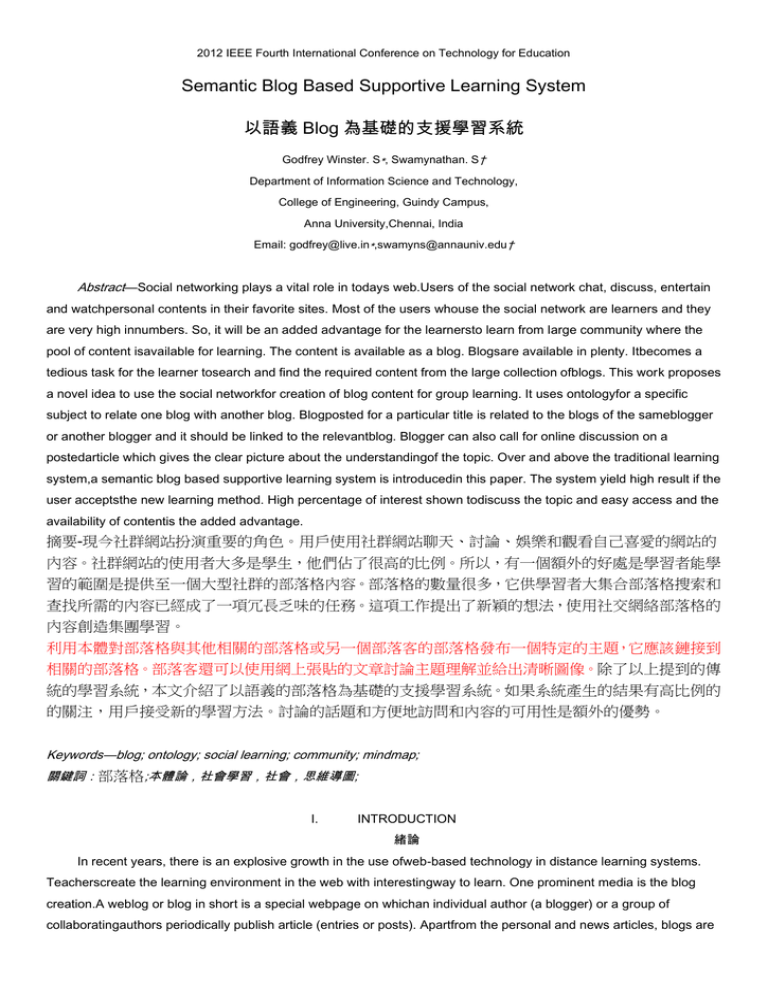Semantic Blog Based Supportive Learning System 以語義 Blog 為基礎的支援學習系統 ∗ †
advertisement

2012 IEEE Fourth International Conference on Technology for Education Semantic Blog Based Supportive Learning System 以語義 Blog 為基礎的支援學習系統 Godfrey Winster. S∗, Swamynathan. S† Department of Information Science and Technology, College of Engineering, Guindy Campus, Anna University,Chennai, India Email: godfrey@live.in∗,swamyns@annauniv.edu† Abstract—Social networking plays a vital role in todays web.Users of the social network chat, discuss, entertain and watchpersonal contents in their favorite sites. Most of the users whouse the social network are learners and they are very high innumbers. So, it will be an added advantage for the learnersto learn from large community where the pool of content isavailable for learning. The content is available as a blog. Blogsare available in plenty. Itbecomes a tedious task for the learner tosearch and find the required content from the large collection ofblogs. This work proposes a novel idea to use the social networkfor creation of blog content for group learning. It uses ontologyfor a specific subject to relate one blog with another blog. Blogposted for a particular title is related to the blogs of the sameblogger or another blogger and it should be linked to the relevantblog. Blogger can also call for online discussion on a postedarticle which gives the clear picture about the understandingof the topic. Over and above the traditional learning system,a semantic blog based supportive learning system is introducedin this paper. The system yield high result if the user acceptsthe new learning method. High percentage of interest shown todiscuss the topic and easy access and the availability of contentis the added advantage. 摘要-現今社群網站扮演重要的角色。用戶使用社群網站聊天、討論、娛樂和觀看自己喜愛的網站的 內容。社群網站的使用者大多是學生,他們佔了很高的比例。所以,有一個額外的好處是學習者能學 習的範圍是提供至一個大型社群的部落格內容。部落格的數量很多,它供學習者大集合部落格搜索和 查找所需的內容已經成了一項冗長乏味的任務。這項工作提出了新穎的想法,使用社交網絡部落格的 內容創造集團學習。 利用本體對部落格與其他相關的部落格或另一個部落客的部落格發布一個特定的主題,它應該鏈接到 相關的部落格。部落客還可以使用網上張貼的文章討論主題理解並給出清晰圖像。除了以上提到的傳 統的學習系統,本文介紹了以語義的部落格為基礎的支援學習系統。如果系統產生的結果有高比例的 的關注,用戶接受新的學習方法。討論的話題和方便地訪問和內容的可用性是額外的優勢。 Keywords—blog; ontology; social learning; community; mindmap; 關鍵詞:部落格;本體論,社會學習,社會,思維導圖; I. INTRODUCTION 緒論 In recent years, there is an explosive growth in the use ofweb-based technology in distance learning systems. Teacherscreate the learning environment in the web with interestingway to learn. One prominent media is the blog creation.A weblog or blog in short is a special webpage on whichan individual author (a blogger) or a group of collaboratingauthors periodically publish article (entries or posts). Apartfrom the personal and news articles, blogs are predominantlyused for learning. Popular software vendors like oracle [4],IBM [5], Microsoft [6] have their own official blog sites todiscuss various new topics of interest. Blogging is appliedto knowledge sharing and interactive discussion. Few blogfeatures such as comments, trackbacks, difficulty levels, andassociation degree related to a specific topic, the best combinationof blog articles is produced as a material. 近年來,運用Web技術在遠程教育系統的數字爆炸性的增長。教師創造學習環境,在網上用有趣的方 式來學習。部落格的創立是一個顯著的傳播媒介。短網志或部落格是一種特殊的合作作者個人作者(部 落格)或一組網頁上定期發布的文章(項目或帖子)。除了來自個人和新聞文章的內容,部落格絕大 部份用於學習。熱門的軟件供應商,如Oracle[4],IBM[5]微軟[6]都有自己的官方部落格網站,應用知 識分享和互動討論,討論各種感興趣的話題。部落格的功能,如評論,引用,難度級別(困難程度), 相關到特定主題的關聯程度,最佳組合的部落格文章。 The challenges in the web based learning is first, the learnercan only read what the publisher publish or what the learningsystem shows to the user. Second, the user cannot have theopportunity to discuss his views. Third, learner can learn onlythe article provided by the faculty or content developer. So ournew semantic blog based supportive learning system proposesa novel idea to enhance the teaching learning process overthe traditional methods. First, instead of webpage, blogs arecreated to publish article or a specific topic. Blogs createdare indexed in reverse chronological order to the user [4].Learner who learns the article can comment the blog with hisopinion about the article. The learner can also link the blogto his blog site. The system also allows the learner to publishthe article with their views. Second, the learner can create acommunity to discuss about the particular topic. Very usefulcomments and knowledge is shared by different learner in thecommunity. Blog discussion is very useful for the learners aswell as the faculty or the content developers. Third, the sociallearning system uses an ontology specific to each subject crawlthe web to collect more relevant content to enhance the topicdiscussed in blog to the learner. 所面臨的挑戰是在Web的學習,首先,學習者只能讀出版社出版或學習系統顯示給用戶的內容。第二, 用戶可以有機會討論他的看法。第三,學習者可以學習由教師或內容開發者提供的文章。因此,我們 的以語義為基礎的部落格的支援學習系統,為教學過程中比傳統還好的教學方法提出了一種新的思想。 首先,以部落格的創建代替網頁,發表文章或某個特定主題。搜尋網志建立的索引,逆時間順序給使 用者。該系統還可以讓學習者發表文章與他們的意見,部落格學習者能對學習的文章發表評論,或發 表他覺得有關的文章。學習者也可以在部落格連結到自己的部落格網站。第二個,學習者可以創建一 個有關特定主題的社群討論。通過不同的學習者在社群中有用的意見和知識分享,對學習者以及教師 或內容開發人員部落格的討論是非常有益。第三,社會學習系統採用本體論,特定於每個主題抓取網 站,以收集更多的相關的內容來增強在部落格中對學習者的話題性。 This paper provides a supportive learning system in additionto the traditional learning system. Semantic blog basedsupportive learning system uses subject specific ontology toretrieve blogs relevant to the subject. Part of sample ontologycreated for subject Operating System(OS) is shown in Fig. 3.It also helps to create relationship to different subject (topic).Faculty can create the mind map which provides clear viewabout the subject. Fig. 2 shows the mind map of the subjectoperating system and it is developed using the MindApp [4]tool. Faculty creates blog for each topic as per the mindmap. Blog created by faculty is semantically annotated usingontology relationship. User searches for specific topic willget the personalized [17] and ranked blogs. Learner willget the blogs published by the faculty of the subject andadditional blogs for that topic published by different researcher(Bloggers). 本文提供了除了傳統的學習系統外的支援學習系統。基於語義部落格的支援學習系統採用本體論檢索 部落格主題相關的特定主題。樣品本體論創建的主題的操作系統(Operating System,OS)的部分 如圖3。這也有助於創造不同的主題與主題之間的關係。教師可以創建思維導圖的主題,提供明確的 看法。如圖2顯示了思維導圖的主題操作系統和開發採用的MindApp工具。教師創建博客,每個主題 根據思維導圖。通過教師創建的部落格是語義上帶註釋的使用本體的關聯。使用者搜索特定主題的個 人化排名部落格。學習者將獲得由教師的主體和額外的部落格,不同的研究者(部落格)發布的主題 發表的部落格。 The contribution of this paper can be summarized as follows. •Blogs are collected from the web using subject specificontology. •Blog creation follows the flow of mind map. •Semantically annotating the blogs with existing blogsusing ontology. •Supportive learning system which gives personalized andranked blogs for user search. The remainder of this paper is organized as follows: Section2 discusses the related work. Section 3 presents the blockdiagram of semantic blog based supportive learning system.Section 4 provides experiments and results. Section 5 containsthe conclusion and future work. 本文的貢獻可以概括如下。 •部落格收集的網頁採用特定主題本體論。 •部落格創立如下的思維導圖的流程。 •與現有的部落格使用本體論語義上標註的部落格。 •支援學習系統,讓用戶搜索個人化排名的部落格。 本文的其餘部分安排如下:第2節討論了相關的工作。第3節提出了基於語義的部落格支援學習系統 的結構框圖。第4節提供了實驗和結果。第5節中包含的結論和未來的工作。 II. RELATED WORK 相關工作 E-learning is one of the major areas where semanticallyinterlinked contents are expected to be organized therebyintended learners can make use of the facilities. Blogs relatingdifferent e-learning categories may be organized in a hierarchicalmanner with proper indexing. Users who frequentlysearch the blogs may be provided with personalized contentbased on their user profile [13].There are several modernauthoring systems to develop adaptive educational hypermedia[1] such as InterBook, Web DCG, DCG+GTE, AHA, ACE,ALE, NetCoach/ART-WEB, ECSAIWeb, MetaLinks, SIGUE,etc., all oriented to educational practitioners. Personalizedrecommender system that uses web mining to recommendthe next links to visit in an AIWBES was discussed byRomero.C, et. al. A specific mining tool was developed and arecommender engine in order to help the teacher to carry outthe web mining process [2].Only with a clear sense of the theoreticalfoundations that underpin assumptions about learningand cognition, can an efficient onlinelearning environment beappropriately designed. These theoretical foundations providethe means to choose an appropriate educational approach.Theselection of an approach can be seen as a pre-design concernand is the result of answering basic questions such as whyis the environment being developed, what is the focus of theenvironment and who the learners are [3].Butterfly modelintroduced for content development and learning, enables alearner to overcome problems faced with earlier content, andactually helps learners learn concepts better through the variousfacets available that learners can choose to navigate andthe navigation is intuitive and easy for learners to understand[7]. Recommendation and personalization techniques can beclassified into three different categories like rule-based filteringsystems, content-filtering systems and collaborative filteringsystems [8]. 電子學習的主要範疇之一,預計將在語義上相互關聯的內容組織成學習者可以運用的設施。有關不同 的電子學習類別的的部落格,可以組織在一個分層的方式與正確的索引。用戶經常搜索的部落格使用 者設定檔的基礎上提供個人化的內容[13]。有幾種現代化的編程系統,適應性教學超媒體,發展[1], 如InterBook,Web DCG,DCG+ GTE,AHA,ACE,ALE,NetCoach/ ART-WEB,ECSAIWeb, MetaLinks,SIGUE等,朝向教育的從業者。使用Web數據挖掘,個性化推薦系統推薦的下一個環節 在AIWBES訪問進行了討論由Romero.C等人。一個具體的挖掘工具的開發和一個推薦引擎,以幫助 該教師進行Web數據挖掘,過程[2]。只有具備一個明確的理論基礎,鞏固學習和認知的假設,可以 提供高效的在線學習環境,適當地設計感。這些理論基礎,提供必要的手段的選擇適當的教育方法。 選擇的的辦法可以被視為一個預先設計的關注的並回答一些基本問題,如為什麼是環境被開發的結果, 環境和學習者是誰的焦點是什麼。蝴蝶模型介紹了發展和學習的內容,使學習者克服所面臨的問題與 較早的內容,有助於學習者學習的各個方面,學生也可以選擇導航以及導航非常易於使學習者理解概 念,更好地通過。推薦和個性化技術可以分為三個不同的類別,如以規則為基礎的過濾系統,內容過 濾系統和協同過濾系統[8]。 Isolated knowledge is useless as it is neither easily retrievednor easily expanded. Learning concerns internalizing andexternalizing knowledge and establishing relations betweenknowledge of various types and from different sources [9].Semantic links between resources can be established in twoways: user definition and automatic discovery. Concept mapgeneration technique which is underpinned by a contextsensitivetext mining method and a fuzzy domain ontologyextraction algorithm can automatically construct concept mapsbased on the messages posted to an online discussion board[10]. 隔離的知識是無用的,因為它既不容易擴展也不容易檢索。學習注意內部化和外部化的知識和建立各 種不同來源的知識之間的關係。語義資源之間的連結可以建立在兩個方面:用戶定義和自動發現。概 念圖生成技術的基礎是一個上下文相關的文本挖掘方法和模糊的領域本體的提取算法可以自動構建 概念圖的基礎上將訊息發布到網上討論區[10]。 Open Smart Classroom provides a novel experience forboth the teacher and students to learn in multiple classrooms.As a prototype learning system, it still has some limitationsthat needto be enhanced, such as providing more standardspecification for new classrooms to join in and improvingthe aided tools to be more operable and effective. Moreover,how to make full use of thelearning environment provided byOpen Smart Classroom to enhance students understanding inthe multicultural class is still an open question, which needsfurther studying [11]. NNexus is the first system that automatesthe process of linking disparate ”encyclopedia” entries into afully connected conceptual network [12]. 開放式智能教室,對教師和學生在多個教室學習提供了一個新的體驗。學習系統作為原型,但它仍然 有一定的局限性,如提供新的教室,需要增加更多的標準規範和完善的輔助工具,更具有可操作性和 有效性。此外,如何充分利用所提供的開放式智能教室,以提高學生的理解多元文化類的學習環境仍 然是一個懸而未決需要進一步研究的問題。NNexus是首個可以自動的過程中,將不同的“百科全書” 項目完全連接到概念網[12]。 The Blogosphere is expanding in an unprecedented speed. Abetter understanding of the blogosphere can greatly facilitatethe development of the Social Web to serve the needs of users,service providers, and advertisers. A prominent feature ofthe Social Web is that many enthusiastic bloggers voluntarilywrite, tag, and catalog their posts in order to reach the widestpossible audience who will share their thoughts and appreciatetheir ideas [14]. 該部落格正以前所未有的速度在擴展。更好地了解部落格社會網絡的發展能極大的方便服務用戶,服 務提供商和廣告商的需求。社會網絡一個突出的特點是,很多熱心的部落客自願寫,標記和編錄的工 作,以達到盡可能廣泛的讀者分享他們的想法和欣賞他們的觀點[14]。 III. SEMANTIC BLOG BASED SUPPORTIVELEARNING SYSTEM 語義的BLOG基於支持性的學習系統 Fig. 1 shows the overall block diagram of semantic blogbased supportive learning system. It contains online blogcollection, preprocessing, faculty blog creation, XML formatting,Blog search. The supportive learning system provides anoption to upload subject specific ontology. Crawler is used inthe system to crawl the web for each subject and collect theblogs relevant to each subject. Blogs collected may containnon-english and incomplete blogs, which are all removed inthe preprocessing stage. Faculties create the subject mind mapusing the MindApp tool to outline the subject. It gives anoverview of the subject. 如圖1顯示了基礎語義的部落格支援學習系統整體框圖。它包括網上博客收集,預處理,教師部落格 創建,XML格式,Blog搜索。支援的學習系統提供了一種選擇,以上傳特定主題本體論。履帶式系統 中使用的為每個主題抓取網站並收集每個主題相關的部落格。部落格可能包含非英語的和不完整的部 落格,這是在預處理階段去除。院系創建的的主體思維導圖使用MindApp工具勾勒出題目。它提供了 一個概要的主題。 Fig. 1. Semantic Blog Based Supportive Learning System 如圖1.基於語義網志的支援學習系統 Fig. 2 shows the sample mind map for subject operatingsystem. This in turn gives the functions of operating system,process management, storage management, IO systems,protection and security etc,. Process Management deals withThreads. A thread in turn contains Multithreading Modelswhich has Many to One Model, One to One Model, Manyto Many Model. Mind map gives a clear idea of the subject 如圖2顯示了採樣的思維導圖用於主題操作系統。這反過來又使操作系統的功能,進程管理,存儲管 理,IO系統,保護及保安等。流程管理的主題處理。又包含一個線程圖多執行緒模式,一對多,一對 一模型,多對多模型。思維導圖給出了一個明確的主題理念 Fig. 2. Simple Mind map for operating system subject 如圖2.簡單的作業系統主題的思維導圖 and what it contains. This helps the learners to get an insight ofthe subject. Blogs are created for each subject according to themind map and the relationship is created using the ontology.It gives the successor and predecessor of each topic in asubject.Blogs collected and created are converted to commonXML format. This facilitates the system with easy retrieval anduniversal acceptable format. XML formatted blogs contain thexml tags like blogpost, keyword, title, description, url, data,author, tags, frequency and contents. XML formatted blogsare stored in blog repository for learner access. 它所包含的內容有助於學習者了解主題。部落格是是使用本體的關係為每個主題創建思維導圖。它使 繼任者和前任每個主題的主體。收集和創建的部落格轉換為常見的XML格式。這便於容易檢索和普遍 可接受的格式的系統。 XML格式的部落格包含的XML標籤一樣的博文,關鍵詞,標題,描述,URL, 數據,作者,標籤,頻率和內容。學習者訪問的部落格信息庫中存儲的XML格式的部落格。 The learner can access the blog content according to hisneed. For example if the learner searches for the blog content’thread’ then all the blogs relevant to the query word from theblog repository is retrieved. Blog retrieved contains the facultypublished blogs and the blogs crawled from the web. Thelearner can suggest the blogs to their friends. They can enterinto discussion about the published article. Blog is an excellentinteractive space for the teacher and learner. As a result ofsearch the learner will get the personalized and ranked blogs.Ranking is done based on Content Based Importance (CBI)[19]. Our previous work on personalization [17] provides thepersonalized semantic blogs. 學習者可以根據自己的需要訪問的部落格內容。例如,如果學習者搜索部落格內容“線”,那麼所有 的相關的部落格在部落格庫的查詢詞進行檢索。部落格檢索包含了教師部落格和從網絡上抓取的部落 格。學習者可以向他們的朋友建議部落格的。他們可以進入討論發表的文章。部落格是一個很好的老 師和學生的互動空間。作為搜索的結果的學習者將獲得個人化排名的部落格。排名是基於內容的重要 性(CBI)的基礎上[19]。我們以前的工作的個性化[17]提供了個人化的的語義部落格。 IV. EXPERIMENTS AND RESULTS 實驗及結果 Semantic blog based supportive learning system is implemented with sample ontology as shown in Fig. 3. The blogs collected are more relevant and sample blog retrieved for query word operating system is shown in Fig. 4. The system isimplemented in a local server to allow access through localnetwork. It is tested with a learner group of 529 studentsof an engineering college affiliated to Anna University. Theygive the feedback about the supportive learning system withdifferent perspective. Fig. 5 and Fig. 6 shows the bar chart of feedback collected 以語義部落格為基礎的支援學習系統實現與樣品本體論的作法示於圖3。收集網志是更相關的並採樣 部落格檢索查詢字操作系統圖4。該系統實施在本地服務器允許通過本地網絡存取。它與Anna大學附 屬一個組學習者的工程學院的529名的進行測試。他們的支援的學習系統,不同的角度給予反饋信息。 如圖圖5和的6的長條圖收集的反饋信息 Fig. 3. Sample ontology for operating system subject 如圖3.操作系統主題的範例本體 Fig. 4. Sample blogs collected for query word Operating System 如圖。4。樣品收集查詢字的操作系統的部落格 from the students for subject without evolving and withevolving technology. Analysis shows that the students aremore interested other than the classroom teaching. These workemphasis the interactive social learning with the traditionallearning methodology. Very good number of leaners impressedand reported excellent feedback for the supportive learningsystem. Analysis clearly says that learners are more interestedtowards the community learning rather than the classroomlearning. Learners are very much interested in the traditionallearning for the subject without evolving technology. Fig. 5clearly shows the view of the learners for the subject probabilityand statistics, data structures and design and analysis ofalgorithms. Our system is analyzed with traditional system andSemantic blog based learning system. Our system yield highernumber learners interest in subjects with evolving technology.Fig. 6 shows the appreciated number of learners interested insocial learning introduced by our supportive learning system. 從學生用於主體的沒有不斷發展的和不斷發展的技術。分析表明,學生們更感興趣的課堂教學以外的。 這些工作重點的互動社交學習與傳統學習方法。相當良好,給學習者留下深刻的印象,並報告極好的 反饋信息用於支援的學習制度。分析明確表示,學生對社會學習而不是在課堂學習更感興趣。學習是 非常有興趣在傳統為主題的學習而不斷發展的技術。如圖5清楚地表明的觀點,學習者的主題的概率 和統計,數據結構和算法設計和分析的。我們的系統進行了分析的與傳統的系統和基礎語義博客學習 系統。我們的系統產生較多學生的學習興趣的主題,不斷發展的技術。如圖。6顯示了在社會學習有 興趣支持我們的學習系統推出的升值。 Fig. 5.Learners feedback for subject without evolving technology Fig. 6.Learners feedback for subject with evolving technology V. CONCLUSION AND FUTURE WORK 總結與展望 Semantic blog based supportive learning system shows thatthe students are more interested in interactive online sociallearning than the traditional classroom learning. The semanticblog based supportive learning system along with traditionallearning system is better than the normal available learningsystem. So the novel idea is better to implement for interactivesocial learning for learners. The work can also extendedto create community learning for the university subjects likethe general topic. This will improve more knowledge sharingamong students and faculty. Classle is a social learning systemwhere all students and faculty can gain and share knowledge[18]. Supportive learning system can also accumulate thefeatures of classle learning social network. 語義博客基礎支援的學習系統使學生在網上互動的社會學習比傳統的課堂學習更感興趣。根據語義的 博客系統與傳統的學習系統支援的學習是優於普通可用性的學習系統。因此,新的想法是互動社交學 習供學習者更好地執行。這項工作也能擴展到創建社區學習大學的科目,如一般的主題。這將提高學 生和教師間的知識共享。Classle是一種社會學習系統性所有的學生和教師可以獲取和分享知識[18]。 支持性性學習系統,也可以積累的classle學習社交網絡的功能。 REFERENCES 參考文獻:


